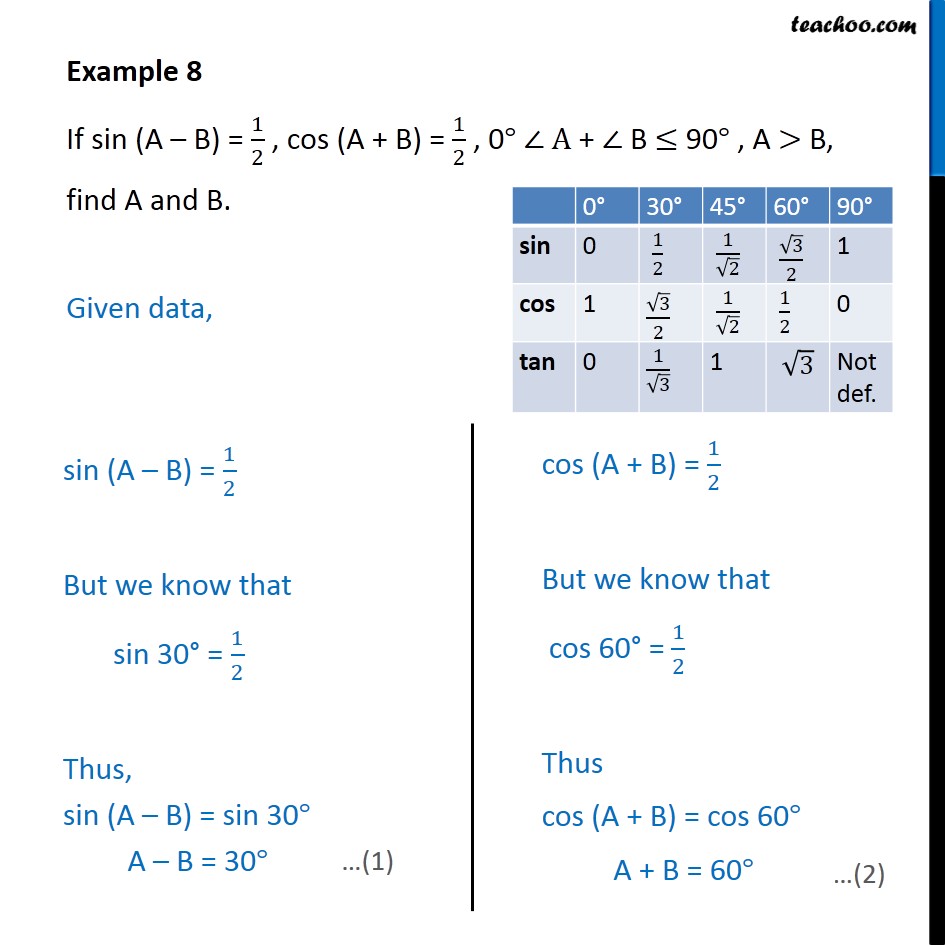Sin(A+B) | Alex thank you exactly what i needed Note that you can get (5) from (4) by replacing b with −b, and using the fact that cos(−b) = cos b (cos is even) and sin by putting a = b = θ. Cos a + cos b = 2 cos. Now we use our algebra skills to rearrange and solve in this case it is best to turn the fractions upside down ( sin a/a instead of a/sin a , etc) We will learn how to find the expansion of sin (a + b + c).
Ignore a/sin a (not useful to us): Cos a + cos b = 2 cos. Now we use our algebra skills to rearrange and solve in this case it is best to turn the fractions upside down ( sin a/a instead of a/sin a , etc) We will learn how to find the expansion of sin (a + b + c). Note that you can get (5) from (4) by replacing b with −b, and using the fact that cos(−b) = cos b (cos is even) and sin by putting a = b = θ.

Note that you can get (5) from (4) by replacing b with −b, and using the fact that cos(−b) = cos b (cos is even) and sin by putting a = b = θ. By using the formula of sin (α + β) and cos (α + β) we can easily expand sin (a + b + c). Alex thank you exactly what i needed We will learn how to find the expansion of sin (a + b + c). Cos a + cos b = 2 cos. Ignore a/sin a (not useful to us): Now we use our algebra skills to rearrange and solve in this case it is best to turn the fractions upside down ( sin a/a instead of a/sin a , etc)
Cos a + cos b = 2 cos. By using the formula of sin (α + β) and cos (α + β) we can easily expand sin (a + b + c). Ignore a/sin a (not useful to us): Note that you can get (5) from (4) by replacing b with −b, and using the fact that cos(−b) = cos b (cos is even) and sin by putting a = b = θ. Now we use our algebra skills to rearrange and solve in this case it is best to turn the fractions upside down ( sin a/a instead of a/sin a , etc)

Ignore a/sin a (not useful to us): Alex thank you exactly what i needed Cos a + cos b = 2 cos. Now we use our algebra skills to rearrange and solve in this case it is best to turn the fractions upside down ( sin a/a instead of a/sin a , etc) We will learn how to find the expansion of sin (a + b + c). Note that you can get (5) from (4) by replacing b with −b, and using the fact that cos(−b) = cos b (cos is even) and sin by putting a = b = θ. By using the formula of sin (α + β) and cos (α + β) we can easily expand sin (a + b + c).
We will learn how to find the expansion of sin (a + b + c). Cos a + cos b = 2 cos. Now we use our algebra skills to rearrange and solve in this case it is best to turn the fractions upside down ( sin a/a instead of a/sin a , etc) By using the formula of sin (α + β) and cos (α + β) we can easily expand sin (a + b + c). Ignore a/sin a (not useful to us):

We will learn how to find the expansion of sin (a + b + c). By using the formula of sin (α + β) and cos (α + β) we can easily expand sin (a + b + c). Now we use our algebra skills to rearrange and solve in this case it is best to turn the fractions upside down ( sin a/a instead of a/sin a , etc) Cos a + cos b = 2 cos. Alex thank you exactly what i needed Note that you can get (5) from (4) by replacing b with −b, and using the fact that cos(−b) = cos b (cos is even) and sin by putting a = b = θ. Ignore a/sin a (not useful to us):
Sin(A+B): By using the formula of sin (α + β) and cos (α + β) we can easily expand sin (a + b + c).
Referanse: Sin(A+B)


Post a Comment